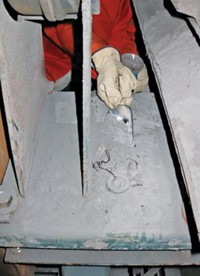Advertisement
Grab your lab coat. Let's get started
Welcome!
Welcome!
Create an account below to get 6 C&EN articles per month, receive newsletters and more - all free.
It seems this is your first time logging in online. Please enter the following information to continue.
As an ACS member you automatically get access to this site. All we need is few more details to create your reading experience.
Not you? Sign in with a different account.
Not you? Sign in with a different account.
ERROR 1
ERROR 1
ERROR 2
ERROR 2
ERROR 2
ERROR 2
ERROR 2
Password and Confirm password must match.
If you have an ACS member number, please enter it here so we can link this account to your membership. (optional)
ERROR 2
ACS values your privacy. By submitting your information, you are gaining access to C&EN and subscribing to our weekly newsletter. We use the information you provide to make your reading experience better, and we will never sell your data to third party members.
Safety
Heads Butt Over Deadly Explosion
Dust Accident: Safety board seeks better maintenance; unions want tougher regulations
by Jeff Johnson
September 24, 2009

An accumulation of airborne sugar dust led to a 2008 explosion and fire that killed 14 and injured 36 workers at the Imperial Sugar plant outside Savannah, Ga., says the Chemical Safety & Hazard Investigation Board (CSB) in a report released this week.
Investigation Details:
Imperial Sugar Company Dust Explosion and Fire
Quicktime Video
Windows Video

Investigation Details:
Imperial Sugar Company Dust Explosion and Fire
Quicktime Video
Windows Video
Video: Imperial Sugar Emergengy Response Video: How Dust Explodes

Video: Imperial Sugar Emergengy Response Video: How Dust Explodes
Video: Imperial Sugar Emergengy Response Video: How Dust Explodes

Video: Imperial Sugar Emergengy Response Video: How Dust Explodes
Video: Imperial Sugar Emergengy Response Video: How Dust Explodes

Video: Imperial Sugar Emergengy Response Video: How Dust Explodes
On the circumstances leading to the Feb. 7, 2008, accident, there is little disagreement between CSB and its frequent ally—labor unions that represent plant workers. But the two are deeply split over what should be done to avoid similar accidents.
The accident's cause was ignition of airborne sugar dust that had accumulated for years due to lousy maintenance and inadequate equipment design. A spark from an overheated conveyor bearing likely triggered the primary blast, which was quickly followed by more powerful secondary explosions and fires that ripped through the plant.
Looking at company documents, the board finds a 40-year failure by Imperial to address dust problems, despite management's knowledge that they posed a threat. The board recommends that Imperial and various trade associations implement better training and housekeeping programs.
The tragedy of industrial dust explosions is not new to the board. In 2006, a CSB study discovered 281 industrial dust accidents—many in chemical plants—over a 25-year period, resulting in 119 worker deaths and 718 injuries. Consequently, CSB recommended that year that the Occupational Safety & Health Administration develop a comprehensive dust regulatory standard.
Three years passed, and last April, OSHA announced it would develop the regulation. However, it has yet to take the first step: an advanced notice of proposed rule-making.
Labor unions say the regulatory process will take years, and they want OSHA to implement a dust standard quickly, on an emergency basis, while it draws up a regulation. They had wanted CSB's support in that recommendation. Because of the lack of support, Jackie Nowell, director of occupational safety and health at United Food & Commercial Workers, the union that represents chemical, sugar, and food workers, is now calling for new leadership at the board.
For its part, CSB Chairman John Bresland says, "The board decided that the best way was to allow OSHA to continue and develop a regulatory program." He says he was "disappointed" in the three-year delay, "but my hope is that OSHA will give the regulation priority and develop it as soon as possible."





Join the conversation
Contact the reporter
Submit a Letter to the Editor for publication
Engage with us on Twitter